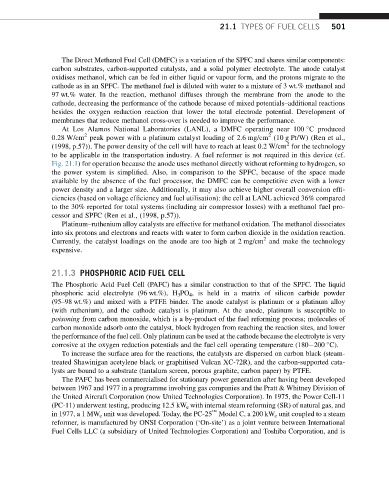Page 508 - Advanced thermodynamics for engineers
P. 508
21.1 TYPES OF FUEL CELLS 501
The Direct Methanol Fuel Cell (DMFC) is a variation of the SPFC and shares similar components:
carbon substrates, carbon-supported catalysts, and a solid polymer electrolyte. The anode catalyst
oxidises methanol, which can be fed in either liquid or vapour form, and the protons migrate to the
cathode as in an SPFC. The methanol fuel is diluted with water to a mixture of 3 wt.% methanol and
97 wt.% water. In the reaction, methanol diffuses through the membrane from the anode to the
cathode, decreasing the performance of the cathode because of mixed potentials–additional reactions
besides the oxygen reduction reaction that lower the total electrode potential. Development of
membranes that reduce methanol cross-over is needed to improve the performance.
At Los Alamos National Laboratories (LANL), a DMFC operating near 100 Cproduced
2
2
0.28 W/cm peak power with a platinum catalyst loading of 2.6 mg/cm (10 g Pt/W) (Ren et al.,
2
(1998, p.57)). The power density of the cellwillhave to reachatleast 0.2 W/cm for the technology
to be applicable in the transportation industry. A fuel reformer is not required in this device (cf.
Fig. 21.1) for operation because the anode uses methanol directly without reforming to hydrogen, so
the power system is simplified. Also, in comparison to the SPFC, because of the space made
available by the absence of the fuel processor, the DMFC can be competitive even with a lower
power density and a larger size. Additionally, it may also achieve higher overall conversion effi-
ciencies (based on voltage efficiency and fuel utilisation): the cell at LANL achieved 36% compared
to the 30% reported for total systems (including air compressor losses) with a methanol fuel pro-
cessor and SPFC (Ren et al., (1998, p.57)).
Platinum–ruthenium alloy catalysts are effective for methanol oxidation. The methanol dissociates
into six protons and electrons and reacts with water to form carbon dioxide in the oxidation reaction.
2
Currently, the catalyst loadings on the anode are too high at 2 mg/cm and make the technology
expensive.
21.1.3 PHOSPHORIC ACID FUEL CELL
The Phosphoric Acid Fuel Cell (PAFC) has a similar construction to that of the SPFC. The liquid
phosphoric acid electrolyte (96 wt.%), H 3 PO 4 , is held in a matrix of silicon carbide powder
(95–98 wt.%) and mixed with a PTFE binder. The anode catalyst is platinum or a platinum alloy
(with ruthenium), and the cathode catalyst is platinum. At the anode, platinum is susceptible to
poisoning from carbon monoxide, which is a by-product of the fuel reforming process; molecules of
carbon monoxide adsorb onto the catalyst, block hydrogen from reaching the reaction sites, and lower
the performance of the fuel cell. Only platinum can be used at the cathode because the electrolyte is very
corrosive at the oxygen reduction potentials and the fuel cell operating temperature (180 200 C).
To increase the surface area for the reactions, the catalysts are dispersed on carbon black (steam-
treated Shawinigan acetylene black or graphitised Vulcan XC-72R), and the carbon-supported cata-
lysts are bound to a substrate (tantalum screen, porous graphite, carbon paper) by PTFE.
The PAFC has been commercialised for stationary power generation after having been developed
between 1967 and 1977 in a programme involving gas companies and the Pratt & Whitney Division of
the United Aircraft Corporation (now United Technologies Corporation). In 1975, the Power Cell-11
(PC-11) underwent testing, producing 12.5 kW e with internal steam reforming (SR) of natural gas, and
Ô
in 1977, a 1 MW e unit was developed. Today, the PC-25 Model C, a 200 kW e unit coupled to a steam
reformer, is manufactured by ONSI Corporation (‘On-site’) as a joint venture between International
Fuel Cells LLC (a subsidiary of United Technologies Corporation) and Toshiba Corporation, and is

